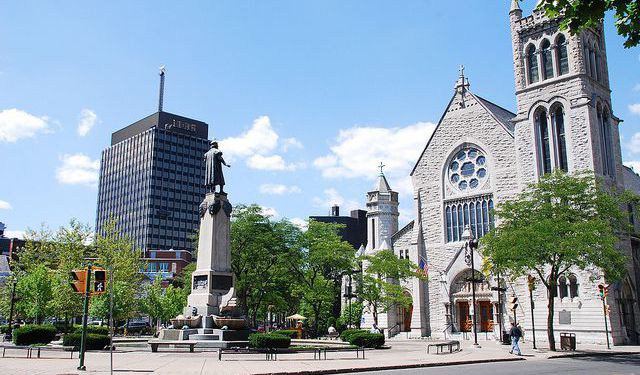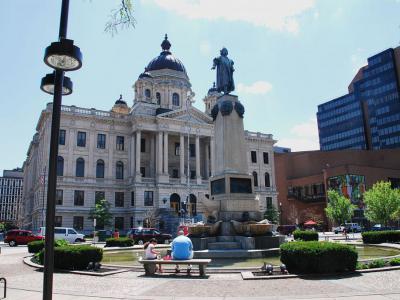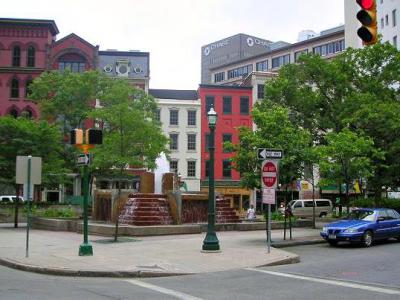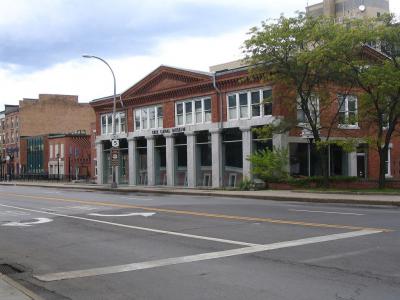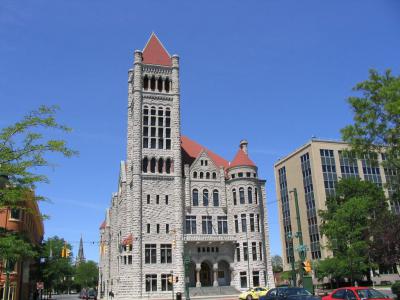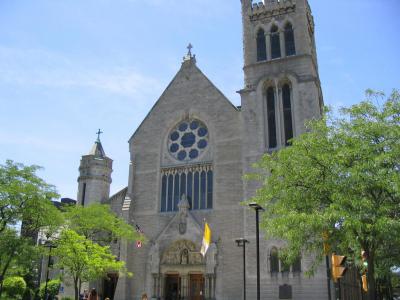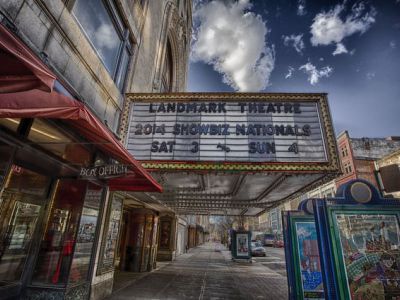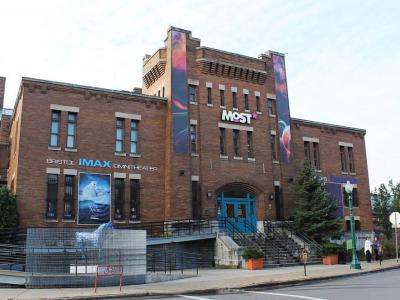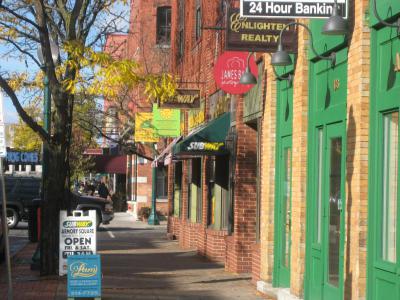Syracuse Introduction Walking Tour (Self Guided), Syracuse
Syracuse is New York's fifth-most populous city and the county seat of Onondaga County. However, these facts only tell part of this city's story. As a significant crossroads throughout local and national history, this city has had a diverse population and contributed much to the nation's economy.
The area's original inhabitants were members of the Onondaga Nation, a tribe that was part of the Iroquois Confederacy. French fur traders, Jesuit priests, and Dutch and English traders were the earliest Europeans to settle here. Syracuse was founded as a town in 1820.
Initially, the salt industry contributed the most to the economy. After the Civil War and through the early 20th century, manufacturing, including furniture building, was popular. Syracuse University, open since 1870, has contributed to growth in the medical and legal fields.
Manufacturing saw an overall increase in the area after World War II, with the automobile industry playing a leading role. Non-tech manufacturing has declined since the 1970s. Services, healthcare, research, and education have filled the void.
Syracuse has iconic squares and plazas that are worth a look, including Clinton Square, Hanover Square, Columbus Circle and Plaza, and Armory Square. For more information on local history, visit The Erie Canal Museum. Science enthusiasts will enjoy The Museum of Science and Technology with its many exhibits.
Take this self-guided walking tour to learn more about Syracuse.
The area's original inhabitants were members of the Onondaga Nation, a tribe that was part of the Iroquois Confederacy. French fur traders, Jesuit priests, and Dutch and English traders were the earliest Europeans to settle here. Syracuse was founded as a town in 1820.
Initially, the salt industry contributed the most to the economy. After the Civil War and through the early 20th century, manufacturing, including furniture building, was popular. Syracuse University, open since 1870, has contributed to growth in the medical and legal fields.
Manufacturing saw an overall increase in the area after World War II, with the automobile industry playing a leading role. Non-tech manufacturing has declined since the 1970s. Services, healthcare, research, and education have filled the void.
Syracuse has iconic squares and plazas that are worth a look, including Clinton Square, Hanover Square, Columbus Circle and Plaza, and Armory Square. For more information on local history, visit The Erie Canal Museum. Science enthusiasts will enjoy The Museum of Science and Technology with its many exhibits.
Take this self-guided walking tour to learn more about Syracuse.
How it works: Download the app "GPSmyCity: Walks in 1K+ Cities" from Apple App Store or Google Play Store to your mobile phone or tablet. The app turns your mobile device into a personal tour guide and its built-in GPS navigation functions guide you from one tour stop to next. The app works offline, so no data plan is needed when traveling abroad.
Syracuse Introduction Walking Tour Map
Guide Name: Syracuse Introduction Walking Tour
Guide Location: USA » Syracuse (See other walking tours in Syracuse)
Guide Type: Self-guided Walking Tour (Sightseeing)
# of Attractions: 9
Tour Duration: 1 Hour(s)
Travel Distance: 1.7 Km or 1.1 Miles
Author: DanaOffice
Sight(s) Featured in This Guide:
Guide Location: USA » Syracuse (See other walking tours in Syracuse)
Guide Type: Self-guided Walking Tour (Sightseeing)
# of Attractions: 9
Tour Duration: 1 Hour(s)
Travel Distance: 1.7 Km or 1.1 Miles
Author: DanaOffice
Sight(s) Featured in This Guide:
- Clinton Square
- Hanover Square
- Erie Canal Museum
- Syracuse City Hall
- Columbus Circle and Plaza
- Cathedral of the Immaculate Conception
- Landmark Theater
- Museum of Science and Technology
- Armory Square
1) Clinton Square (must see)
Clinton Square is one of the premier attractions in Syracuse, famous for the 19th and early 20th-century architecture present in its buildings. This area was the original town square, and the Erie Canal once ran through a park in the square. Today, the park is host to a fountain with a pool that doubles as a skating rink during the winter months.
One of the highlights on the square's northern side is the Soldiers and Sailors Monument, dedicated in 1910. This monument pays homage to the Civil War veterans from the Syracuse area, totaling over 22,000. The Soldiers and Sailors Monument is one of the most eye-catching attractions on the square for its carvings, including flags and military insignias.
Another famous landmark on this square is the Jerry Rescue Monument. The monument commemorates a fugitive slave's rescue in 1851, an event that is a source of pride for local residents. Both of the memorials are excellent examples of the importance that history plays in this city.
The square is an excellent place for taking photos or just relaxing and people-watching. There are benches where you can easily catch a quick break for a few minutes. You will be able to see why so many locals enjoy this area even when no special events are happening.
You might be able to catch bands playing here during the summer, including local jazz artists. Several festivals, including the annual Polish Festival, take place here. Clinton Square is also home to the city's Christmas Tree.
One of the highlights on the square's northern side is the Soldiers and Sailors Monument, dedicated in 1910. This monument pays homage to the Civil War veterans from the Syracuse area, totaling over 22,000. The Soldiers and Sailors Monument is one of the most eye-catching attractions on the square for its carvings, including flags and military insignias.
Another famous landmark on this square is the Jerry Rescue Monument. The monument commemorates a fugitive slave's rescue in 1851, an event that is a source of pride for local residents. Both of the memorials are excellent examples of the importance that history plays in this city.
The square is an excellent place for taking photos or just relaxing and people-watching. There are benches where you can easily catch a quick break for a few minutes. You will be able to see why so many locals enjoy this area even when no special events are happening.
You might be able to catch bands playing here during the summer, including local jazz artists. Several festivals, including the annual Polish Festival, take place here. Clinton Square is also home to the city's Christmas Tree.
2) Hanover Square
Hanover Square is at the intersection of East Gennessee, Water, and Warren Streets in Syracuse. This area also hosts seventeen historic buildings that feature architectural styles ranging from Second Empire to Louis Sullivan and Federal. Some of the oldest buildings date back to when this area of Syracuse was the commercial district in the 1830s.
Examples of some of the buildings include the 1867 Gridley building, featuring Onondaga limestone, the 1894 Gere Bank Building crafted of brick, granite, and terra cotta, and the 1927 Art Deco-style State Tower Building with brick and limestone. These buildings are impressive regardless of whether you are an architecture enthusiast.
This unique plaza is on the National Register of Historic Places, showcasing the importance of many of the buildings found here. There are plenty of shade trees that help make Hanover square a relaxing place to enjoy some time off. Annual flowers add some extra color and serve as a complement to the fountain.
Examples of some of the buildings include the 1867 Gridley building, featuring Onondaga limestone, the 1894 Gere Bank Building crafted of brick, granite, and terra cotta, and the 1927 Art Deco-style State Tower Building with brick and limestone. These buildings are impressive regardless of whether you are an architecture enthusiast.
This unique plaza is on the National Register of Historic Places, showcasing the importance of many of the buildings found here. There are plenty of shade trees that help make Hanover square a relaxing place to enjoy some time off. Annual flowers add some extra color and serve as a complement to the fountain.
3) Erie Canal Museum (must see)
The Erie Canal Museum has welcomed visitors since 1962. This museum is open seven days a week to provide maximum opportunity for enjoying the exciting exhibits inside. The admission is free as well, allowing you to focus on seeing all the excellent sights found inside.
The 1850 Syracuse Weighlock Building hosts a lock chamber designed to weigh ships to collect tools that paid for waterway maintenance. This building housing the weighlock provides fascinating background information on how this process worked and the preservation efforts that have been made.
One of the signature permanent exhibits is the Erie Canal Made New York. Original artifacts and interactive displays help give visitors a clearer picture of how vital this waterway has been. There are also narrative audio tracks that help provide further insight into some of the facts highlighted in the exhibit.
The Weight Chamber boasts a full-size boat replica, and there is also a Locktender's Garden featuring plants and flowers that would have been popular in the Victorian era. Murals and artwork help provide a fascinating artistic interpretation of life in this area. The exhibits on the second floor include a replica of the general store and other locations that offer a closer look at life during the early days.
Why You Should Visit:
An easy way to gain further knowledge of the creation of the Erie Canal, at no cost
Tips:
Take advantage of the audio tracks for Erie Canal Made New York, so you don't miss any of the details.
The 1850 Syracuse Weighlock Building hosts a lock chamber designed to weigh ships to collect tools that paid for waterway maintenance. This building housing the weighlock provides fascinating background information on how this process worked and the preservation efforts that have been made.
One of the signature permanent exhibits is the Erie Canal Made New York. Original artifacts and interactive displays help give visitors a clearer picture of how vital this waterway has been. There are also narrative audio tracks that help provide further insight into some of the facts highlighted in the exhibit.
The Weight Chamber boasts a full-size boat replica, and there is also a Locktender's Garden featuring plants and flowers that would have been popular in the Victorian era. Murals and artwork help provide a fascinating artistic interpretation of life in this area. The exhibits on the second floor include a replica of the general store and other locations that offer a closer look at life during the early days.
Why You Should Visit:
An easy way to gain further knowledge of the creation of the Erie Canal, at no cost
Tips:
Take advantage of the audio tracks for Erie Canal Made New York, so you don't miss any of the details.
4) Syracuse City Hall
Syracuse City Hall has been the seat of Syracuse's city government since its opening in 1889. This building's unique architecture is in a Romanesque Revival style. Like many historic buildings in this city, the hall features a construction of Onondaga limestone, which helps give the building its impressive look, often described as fortress-like.
One of the highlights of the building is a 165-foot bell tower, initially hosting a brass bell. This bell was melted down for use as part of the war effort when World War II occurred. An electronic carillon was installed in 1987, with the generosity of the local Rotary Club.
This building retains many of its most iconic features, such as arched doorways and doors with leaded glass. An interesting historical touch that visitors can also see are original lampposts in front of the building, upgraded for electricity but still featuring the design of the original gas lights.
One of the highlights of the building is a 165-foot bell tower, initially hosting a brass bell. This bell was melted down for use as part of the war effort when World War II occurred. An electronic carillon was installed in 1987, with the generosity of the local Rotary Club.
This building retains many of its most iconic features, such as arched doorways and doors with leaded glass. An interesting historical touch that visitors can also see are original lampposts in front of the building, upgraded for electricity but still featuring the design of the original gas lights.
5) Columbus Circle and Plaza
Columbus Circle and Plaza in Syracuse is one of the more popular neighborhoods and plazas in downtown Syracuse. The monument to Christopher Columbus that stands as a major centerpiece of the plaza dates to 1934. Its architect was Dwight James Baum, a Syracuse-born architect famous for his designs in the region.
Two cathedrals are at either side of the square, the Catholic Immaculate Conception and the Episcopal St. Paul's, both of which have been important to local immigrant communities. There are also two essential government buildings housed in this square. One of these is the Onondaga County Courthouse, while the other, which houses the count's offices, is the John H. Mulroy Civic Center.
This plaza is an excellent place for a leisurely walk, with plenty of shade trees. The area around the plaza is one of the city's most popular places for events. Even during times without scheduled events, the area is a perfect place to visit for a greater appreciation of the city's history and how the local churches have played a role.
Two cathedrals are at either side of the square, the Catholic Immaculate Conception and the Episcopal St. Paul's, both of which have been important to local immigrant communities. There are also two essential government buildings housed in this square. One of these is the Onondaga County Courthouse, while the other, which houses the count's offices, is the John H. Mulroy Civic Center.
This plaza is an excellent place for a leisurely walk, with plenty of shade trees. The area around the plaza is one of the city's most popular places for events. Even during times without scheduled events, the area is a perfect place to visit for a greater appreciation of the city's history and how the local churches have played a role.
6) Cathedral of the Immaculate Conception
The Cathedral of the Immaculate Conception dates to 1910. One of the church's most beloved highlights is its Shrine of the Blessed Mother. The statue's artist is Jacqueline Belfort-Chalat, a professor at LeMoyne College. This area is a popular place for visitors to pray in the cathedral, along with the area near the Sacred Heart Altar.
Besides being a popular place for prayer and reflection, the area near the Sacred Heart Altar is host to another important piece of art. This area features a mosaic in honor of Saint Marianne Cope, a Franciscan sister from central New York. The saint became known for ministering to a colony of lepers in Hawaii.
Concerts and musicals are regular events here, in addition to the daily Masses. Local colleges and high schools make up some of the most frequent performers. Professional groups have also performed at the cathedral because of its excellent acoustics.
Besides being a popular place for prayer and reflection, the area near the Sacred Heart Altar is host to another important piece of art. This area features a mosaic in honor of Saint Marianne Cope, a Franciscan sister from central New York. The saint became known for ministering to a colony of lepers in Hawaii.
Concerts and musicals are regular events here, in addition to the daily Masses. Local colleges and high schools make up some of the most frequent performers. Professional groups have also performed at the cathedral because of its excellent acoustics.
7) Landmark Theater (must see)
The Landmark Theater dates back to the 1920s when movie places were at the height of their popularity. This theater is the only location of this kind surviving in the area. The Landmark enjoys status on the National Register of Historic Places, which is a testament to its important place in local history.
The theater's design is known as Oriental-style, including a unique blend of European, Venetian, Byzantine, and Romanesque elements. Original red and gold decor that was common in these types of theaters may still be found here. The lobby, which has undergone restoration, is open to the public during special events.
Some of the top musical and standup comedy acts have been performed in this theater since its reopening in 1979. The theater can host quality concerts, as well as full theatrical productions. Visitors will be interested in learning more about what might be going on t the theater at any time.
The theater's design is known as Oriental-style, including a unique blend of European, Venetian, Byzantine, and Romanesque elements. Original red and gold decor that was common in these types of theaters may still be found here. The lobby, which has undergone restoration, is open to the public during special events.
Some of the top musical and standup comedy acts have been performed in this theater since its reopening in 1979. The theater can host quality concerts, as well as full theatrical productions. Visitors will be interested in learning more about what might be going on t the theater at any time.
8) Museum of Science and Technology (must see)
The Museum of Science and Technology in Syracuse, also known as the Milton J. Rubenstein Museum of Science, is a fun museum for visitors of all ages to enjoy. The 35,000 square feet of exhibits provide something for everyone, no matter what branch of science interests them the most. There are also planetarium shows and IMAX movies that are always sure to please.
See lifelike dinosaurs at the Dino Zone, try your hand at digging a fossil in the Earth Science Discovery Cave, and learn more about the power grid at Powering Our Future. Check out Lockheed Martin Flight & Space to learn more about what we have accomplished with space flight. Enjoy watching the ball as it makes its way through the Technotown Sculpture.
Stop by the Rothschild Apothecary Shop for a look at how 19th-century pharmacies operated. Learn more about the process of becoming a ham radio operator. If you have kids with you, they won't want to miss the opportunity to try the Science Playhouse.
See lifelike dinosaurs at the Dino Zone, try your hand at digging a fossil in the Earth Science Discovery Cave, and learn more about the power grid at Powering Our Future. Check out Lockheed Martin Flight & Space to learn more about what we have accomplished with space flight. Enjoy watching the ball as it makes its way through the Technotown Sculpture.
Stop by the Rothschild Apothecary Shop for a look at how 19th-century pharmacies operated. Learn more about the process of becoming a ham radio operator. If you have kids with you, they won't want to miss the opportunity to try the Science Playhouse.
9) Armory Square
Armory Square is one of Syracuse's busiest neighborhoods. There are 46 historic buildings, ranging from the 1870s to the 1920s, in their construction eras. This district has been on the National Register of Historic Places since 1984 and is very popular with visitors wanting to catch a glimpse of what life was like during these times.
The Shot Clock Monument is one of the most popular landmarks, located near benches that visitors enjoy relaxing on. There is a paved multi-use trail that passes through this area and provides a connection to Onondaga Lake. The local businesses in this square help make everything stand out.
Upscale restaurants serving different types of cuisine are popular here, as well as coffeehouses. You will also find independent and chain shops that sell everything from clothing to records. This square is also a popular place for local nightlife, with several bars and nightclubs.
The Shot Clock Monument is one of the most popular landmarks, located near benches that visitors enjoy relaxing on. There is a paved multi-use trail that passes through this area and provides a connection to Onondaga Lake. The local businesses in this square help make everything stand out.
Upscale restaurants serving different types of cuisine are popular here, as well as coffeehouses. You will also find independent and chain shops that sell everything from clothing to records. This square is also a popular place for local nightlife, with several bars and nightclubs.
Walking Tours in Syracuse, New York
Create Your Own Walk in Syracuse
Creating your own self-guided walk in Syracuse is easy and fun. Choose the city attractions that you want to see and a walk route map will be created just for you. You can even set your hotel as the start point of the walk.
Historical Churches Walking Tour
Syracuse, NY is a melting pot of religious traditions and beliefs, which is evident in the local religious architecture. Most Christians in the city are Catholic, reflecting the influence of 19th and early 20th-century immigration patterns, when numerous Irish, German, Italian and eastern European settlers. Other than Catholic, there are dozens of other churches in the city, including Eastern... view more
Tour Duration: 1 Hour(s)
Travel Distance: 2.0 Km or 1.2 Miles
Tour Duration: 1 Hour(s)
Travel Distance: 2.0 Km or 1.2 Miles
The Most Popular Cities
/ view all
